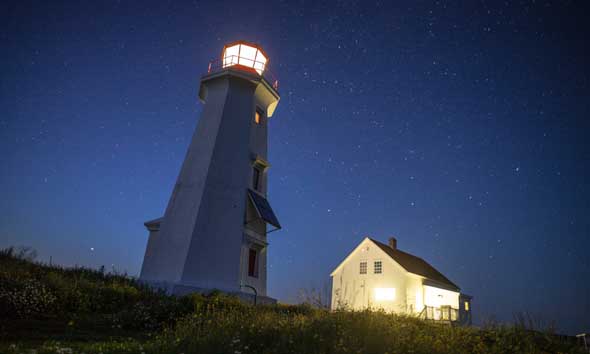Heritage lighthouses evaluation and criteria

Heritage designation criteria are used to identify and articulate the historical, architectural, and community values of potential heritage lighthouses.
The Minister responsible for Parks Canada may designate a nominated lighthouse as a heritage lighthouse under the Heritage Lighthouse Protection Act, taking into account the advice of an advisory committee and established criteria.
Advisory committee
The Act requires the Minister to consult with an advisory committee before determining if a nominated lighthouse (and any related building) should be designated.
The Minister appointed the Historic Sites and Monuments Board of Canada (the Board) as the advisory committee for the Act. The Board advises the Minister on the commemoration of national historic sites, persons and events and is composed of representatives from each of the provinces and territories, as well as one representative each from Library and Archives Canada and the Canadian Museum of History.
Criteria used to designate heritage lighthouses
In consultation with the Board, the Minister established the following designation criteria to identify and articulate the historical, architectural, and community values of potential heritage lighthouses.
The Board will recommend designation under the Act if its evaluation results in:
- two scores of A;
- one score of A, plus two scores of B, and not more the one score of D; or
- four scores of B.
Criterion 1
Criterion 1: Historical values — Reflecting an important theme in Canadian maritime history
This criterion aims to situate and evaluate the lighthouse’s importance in the larger history of the Canadian lighthouse system. Many historical themes may be invoked, including Canada’s earliest lighthouses; expansion of the aids to navigation system; shipwrecks; lightkeeping and life-saving; and lighthouse legend and lore.
How well does the lighthouse reflect an important theme in Canadian maritime history?
- It is an excellent example
- It is a very good example
- It is a good example
- It is an obscure example
Criterion 2
Criterion 2: Historical values — Illustration of the socio-economic development of the associated community
This criterion places particular value on those lighthouses and lightstations whose establishment are meaningfully associated with a significant event, movement or developmental phase in their associated communities. For the purposes of the criterion, an “associated community” is a clearly defined population centre or a community of users, such as mariners and industry. There may be more than one community to consider.
How well does the lighthouse (or lightstation) illustrate the socio-economic development of its associated community?
- It is an excellent example
- It is a very good example
- It is a good example
- It is an obscure example
Criterion 3
Criterion 3: Architectural values — Aesthetic / visual quality of the lighthouse, in the context of its design type
This criterion evaluates a lighthouse’s aesthetic / visual quality against others of a comparable design, and distinguishes the “excellent” and “very good” from other examples. Under this approach, even architecturally simple design types may produce “excellent” or “very good” examples if they have aesthetic or visual merit. To encourage a system of Heritage Lighthouse Protection Act designations that reflects the Canadian lighthouse system as a whole, comparative analyses should be limited, in so far as possible, to comparable lighthouses that are eligible for evaluation under the act.
What is the aesthetic / visual quality of the lighthouse, in the context of its design type?
- It is an excellent example
- It is a very good example
- It is a good example
- It is an obscure example
Criterion 4
Criterion 4: Architectural values — Quality of the design, structural innovation, craftsmanship, materials, optical or audible technologies, and/or functionality of the lighthouse
This criterion assesses the actual execution of the design, with a focus on quality, as well as the building’s suitability in relation to its primary functions. In other words, it aims to evaluate the overall success of the building program.
What is the quality of the design, structural innovation, craftsmanship, materials, optical or audible technologies, and/or functionality of the lighthouse?
- Excellent
- Very good
- Good
- Fair
Criterion 5
Criterion 5: Community values — Visual influence on the present character of the area
This criterion assesses the visual influence of the lighthouse on its surrounding built and/or natural environment.
What is the visual influence of the building on the present character of the area with which it is associated?
- It establishes the present character
- It reinforces the present character
- It is compatible with the present character
- It is a negative influence on the present character
Criterion 6
Criterion 6: Community values — Identity with its associated community
This criterion is concerned with the lighthouse’s present-day social importance, for example as a meeting place, as a tourist attraction or as an integral component of a community’s maritime identity. An “associated community” is a clearly defined population centre or community of users, such as mariners and industry. There may be more than one community to consider.
What is the nature of the lighthouse’s identity with its associated community?
- It is the symbol of an associated community
- It is a highly valued resource for an associated community
- It is valued by an associated community
- It is not a recognized resource
Related buildings
The Heritage Lighthouse Protection Act authorizes the designation of a lighthouse’s “related buildings,” which are broadly defined in the legislation as “any building on the site on which the lighthouse is situated that contributes to the heritage character of the lighthouse.” Related buildings, such as keepers’ dwellings and fog alarm buildings, may be designated as complementary buildings that contribute to the heritage character of a designated lighthouse. A related building that merits designation will contribute directly to a lighthouse’s heritage character and its character-defining elements, as determined by the Board.
- Date modified :